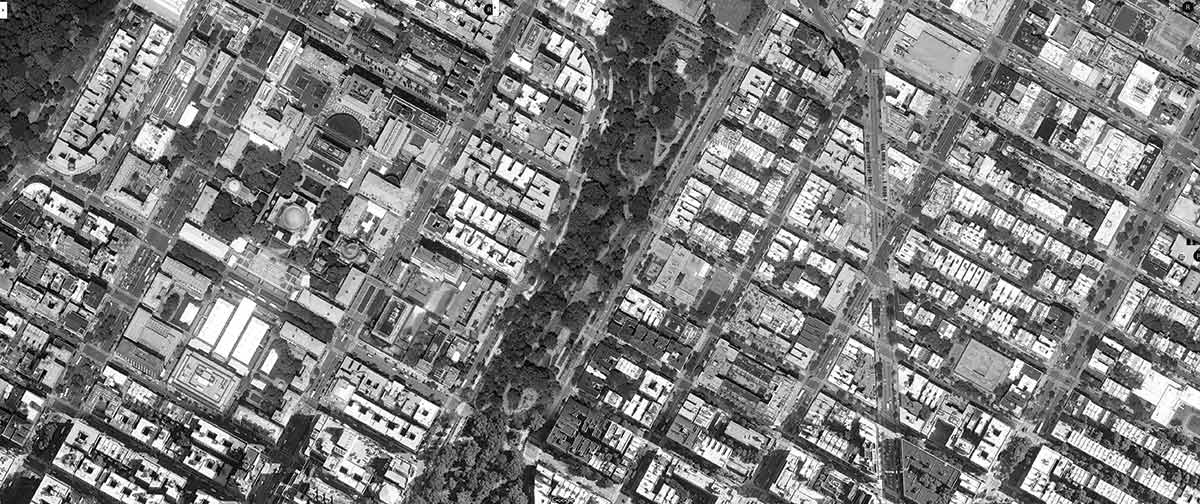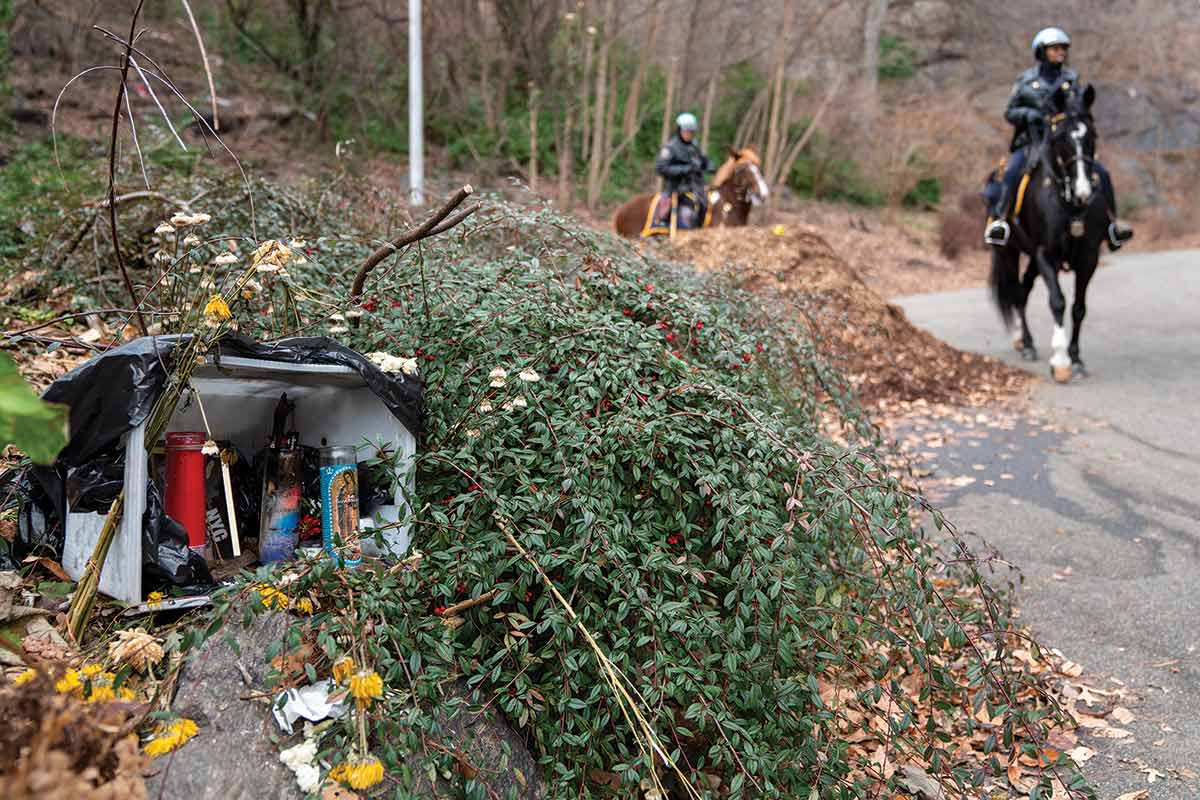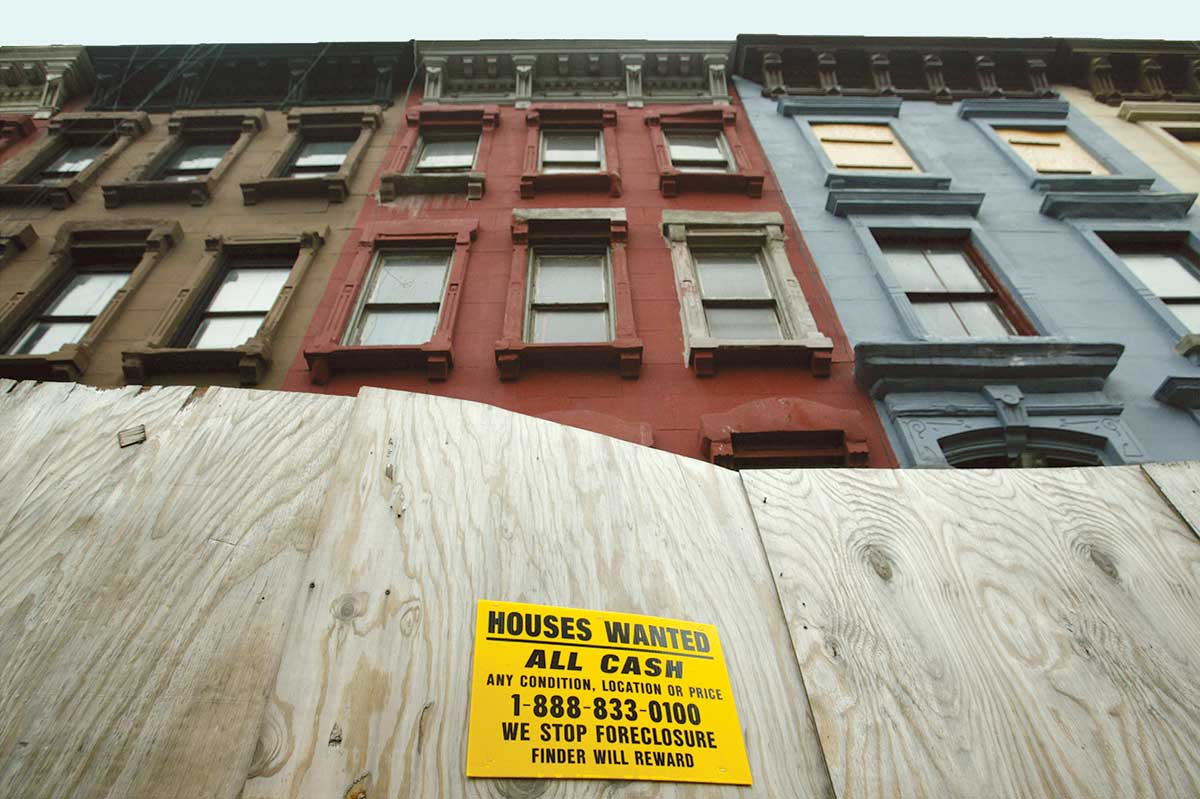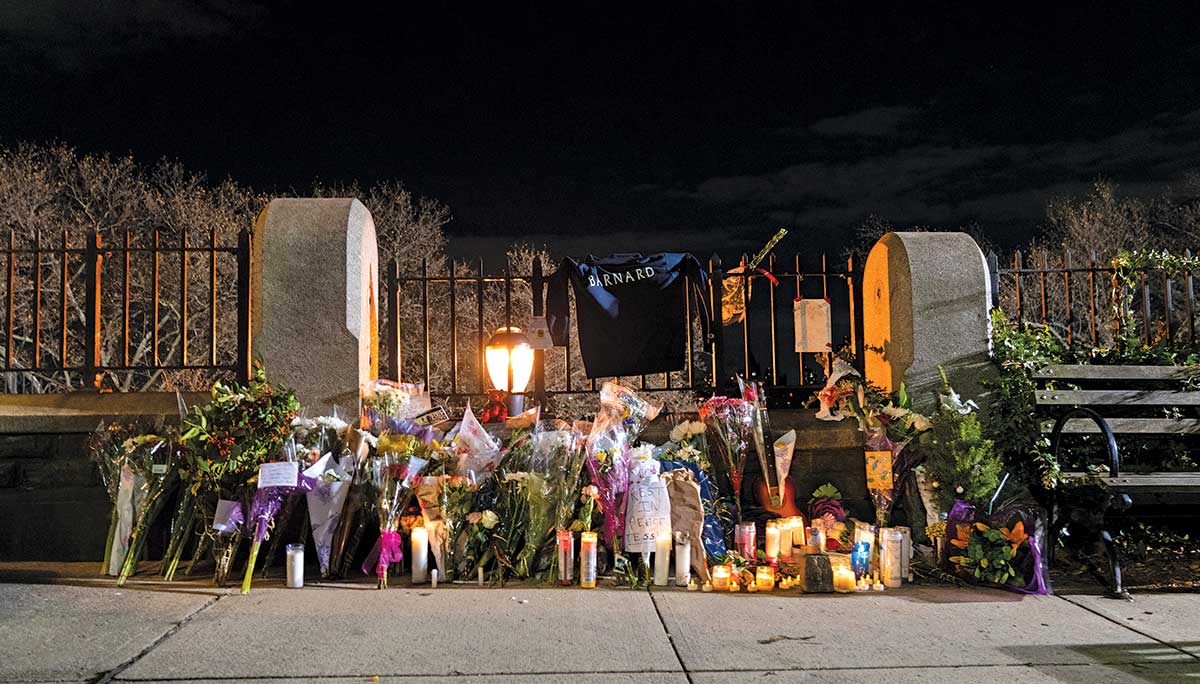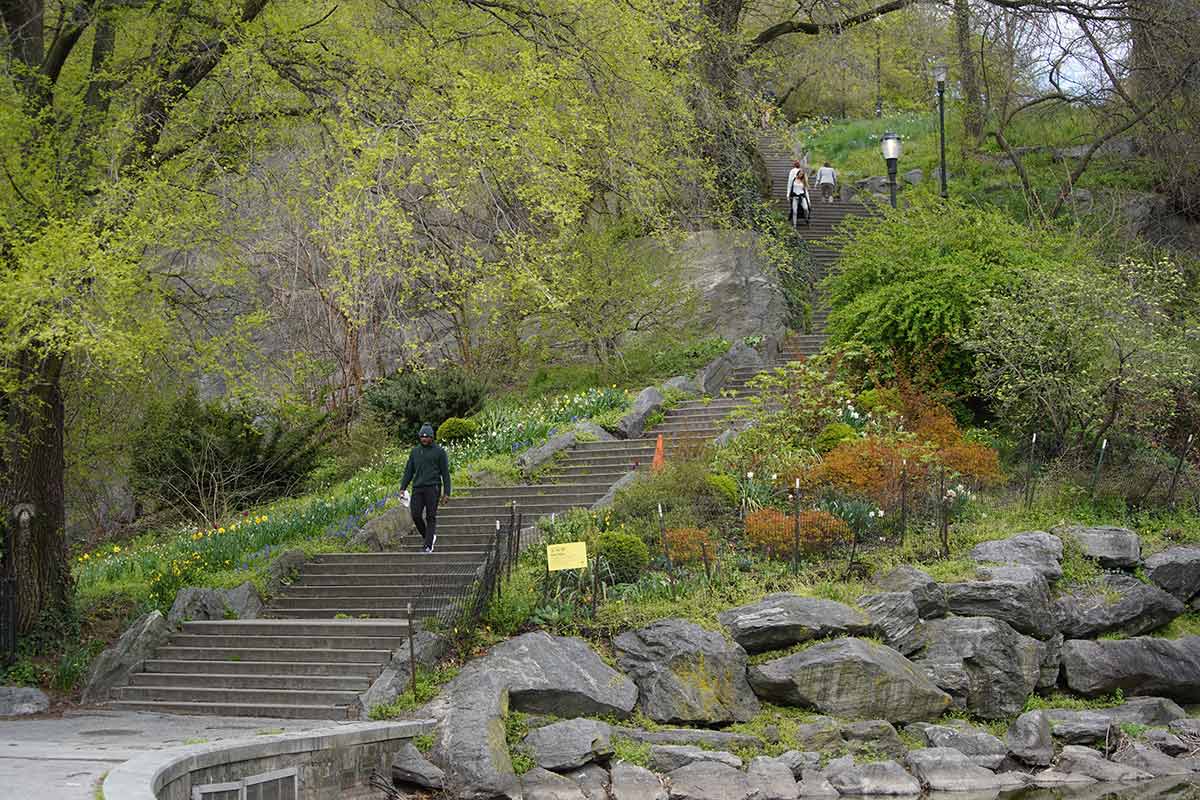One day after Donald Trump floated down a gilded escalator to announce his presidential candidacy, a young white supremacist murdered nine black people who’d welcomed him into their weekly Wednesday night church study group in Charleston, S.C. The next day I moved to Harlem, blocks away from Morningside Park and Central Park, and I’ve never felt such a sense of belonging. It took me a while to make those connections, but they’ve found me over time.
One of the first things I did after moving here was track down a local meditation group and show up to its regular Wednesday drop and sit. My first night there, I watched as community people filed in, a mix of races, and loved it immediately. But soon I found myself, eyes closed, thinking about that welcoming Charleston church group just a few Wednesdays earlier. As practice got underway and a few people came in late, quietly taking their seats, I realized that nobody had locked the door. Was I afraid? And of what? I chastised myself for my unease. On that night, a white person in Harlem was safer than black people were in their own church in Charleston. And on every visit after, for the past five years.
Of course, none of us are ever fully safe anywhere. A horrible example arrived virtually at my doorstep last December, a crime that drew national attention: A Barnard College first-term student, 18-year-old Tessa Majors, was killed walking through Morningside Park just after dark. Unlike in Charleston, it was not a racial crime, though Majors was white and three local African Americans, one 13 years old and two 14, were soon identified as suspects, allegedly in an attempted robbery that turned deadly.
The killing, a few short blocks away from my home, threatened Harlem’s growing sense of itself as a neighborhood that is warm, thriving, and safe. I know: As a gentrifier who has barely lived here five years, I probably shouldn’t speak for Harlem, long a citadel of black politics and culture. But living here, I saw the crime’s impact, which landed differently on newcomers, mostly white, than on longtime residents, mostly black and brown. It threatened community activists’ efforts to get police as well as newcomers to see black and brown youths as youths, not criminals. And it challenged newcomers to admit their unconscious fears about their new home—as I have had to do with mine over these last tough months.
The pace of demographic change in Harlem has been dizzying. Two decades ago, my local friends say, you almost never saw a white resident. But between 2000 and 2018, the neighborhood went from 2 percent white to 14 percent while the black population dropped from 77 percent to 56 percent. Crime rates fell dramatically as well. Morningside Park and much of the Morningside Heights neighborhood lie in the New York Police Department’s 26th Precinct, which averaged more than a dozen murders and two dozen rapes annually in 1990; those numbers were down by 87 and 65 percent, respectively, in 2019, and burglaries had dropped more than 90 percent. To the “more dangerous” east, in the 28th Precinct (where I live), the numbers are somewhat higher, but the declines are roughly the same. Rape, murder, and burglary have declined 84, 88, and 90 percent, respectively, since 1990.
Popular
"swipe left below to view more authors"Swipe →
Neighborhood change can also be measured by the number of new fun and fancy restaurants and bars; my stretch of Frederick Douglass Boulevard came to be known as Harlem’s Restaurant Row in the early aughts. Now there’s Melba’s and Harlem Food Bar, Lido and Vinateria, Zoma and Harlem Tavern, and many more. I first came up here to eat and drink, not live, but I wound up staying for the multiracial sense of community.
Yet not all of my community can enjoy these changes. There are now two Harlems: one restaurant- and bar-hopping, racially integrated but notably white, the other struggling economically and mainly black and Latino. In Central Harlem South, white households have a median annual income of $103,000, three times that of black and Latino households, according to a 2018 report by the Citizens Committee for Children. Harlem-wide, the black unemployment rate was 9.24 percent in 2018, versus 4.62 percent for whites.
The killing of Majors threatened to divide the two Harlems. It triggered communitywide post-traumatic stress disorder, as police swarmed the park and the surrounding area and local and national media stigmatized the neighborhood once again. Six weeks later, though, most sides of the neighborhood came together at a forum organized by Friends of Morningside Park, a nonprofit that raises money and recruits volunteers to improve the park, and Manhattan Borough President Gale Brewer, along with other politicians and community groups. Everybody was fighting not to make this another sad old story, always written by outsiders, about the impossibility of living, thriving, safely in Harlem. “The proof is what happens after,” Aissatou Bey-Grecia, the vice president of Friends of Morningside Park, said at the forum. “It’s not the end of today. It’s what happens next month, what happens over the summer.”
The next month, of course, the whole city was headed into lockdown, as it may well be through the summer. Many of the police who swarmed the park after the killing remain, but almost all of the families and teenagers who frequented it are gone. The hospitals that offered resources to the park community and its young people are now in their own crisis. The three juvenile suspects are locked up in Crossroads Detention Center in the Brownsville neighborhood of Brooklyn, their trial dates uncertain. Meetings to follow up on the promises made to the community by local officials were canceled. “I worry about losing momentum now,” Brad Taylor, the president of Friends of Morningside Park, told me just as the pandemic crisis began. Within a few days, we both worried more about losing neighbors.
Majors was killed on December 11, during final exams. Third-year Barnard classics student Aditi Rao remembers getting the first notification about a nearby crime just after 7 pm that Wednesday. “We get a lot of public safety announcements. A lot are like ‘A bike was stolen on 125th Street.’” This one was more ominous, reporting something like “a Columbia student was involved in a robbery,” she recalls.
“Around 9 we got word that a first-year student had been fatally involved in a robbery. Everybody panicked, contacting all the first-years they knew, and the first-years all panicked, being asked if they were alive,” Rao says somberly. “Getting Tess’s name was just the final confirmation that something irreparably bad had happened.”
Rao knew Majors from a distance; both were part of the university’s music scene. The blue-green-haired (formerly blond) Majors, a young feminist iconoclast, had her own band, Patient 0, which released its first album, Girl Problems, last September, and Rao deejayed at the university radio station. “She seemed a very sweet and kind person. Like a lot of first-years, she expressed a lot of joy and happiness just being on campus.”
Majors and Rao had something else in common: Neither was afraid to traverse Morningside Park, a narrow greenway that stretches from 110th to 123rd Streets, to get between their campus and Harlem to the east. In fact, Rao says, she crossed the park just 24 hours before Majors was killed, returning from Double Dutch Espresso, a local coffee shop. (Full disclosure: Rao is a friend of my daughter’s.) Rao says she made that walk across the park from my neighborhood regularly, but her friends didn’t always go along.
“They’d say, ‘Oh, can’t we just walk along 110th Street?’” she says with a chuckle over the phone. (The rectangular detour adds at least 15 minutes to the hike.) “White students in particular talked a lot about how unsafe the park was,” adds Rao, who is South Asian.
Almost immediately, some students “racialized” the crime, she recalls. On December 12 she tweeted, “You can critique the school for not making you feel safe and protected w out the anti-Harlem rhetoric…. we’ve all been told that Morningside Park is ‘unsafe’ and every time it’s said, even now, it’s coming from a place of anti-blackness.”
Rao got some student blowback for her tweet, but that’s certainly how some in the Harlem community perceived it. “The way the Police Department was talking about all these kids as thugs, using language that criminalized them, was wrong,” longtime local youth advocate Iesha Sekou, the CEO of Street Corner Resources, tells me. She says parents reported that they saw “police were swiping, swabbing the mouths of these young boys” in the neighborhood to collect DNA. Everybody agrees, though, that some police presence was overdue. Friends of Morningside Park and other local activists had long been asking for more policing—specifically, Taylor says, three full-time park patrols, especially officers on foot, and improved lighting. But the response to the killing wasn’t just more patrols; it was an occupation, with police cars and vans at virtually every entrance to the park and tall clusters of floodlights that kept neighbors from sleeping.
“It was just a dramatic overreaction,” says Jane Spinak, a Columbia University law professor who specializes in juvenile justice and is active in Friends of Morningside Park. Having lived in the neighborhood for 31 years, Spinak thought Columbia, Barnard, and the local precinct were overcompensating for not having paid enough attention to park security in the months before Majors was killed. After a string of robberies and an attack on a long-time LGBTQ activist there last spring, the leaders of the 26th Precinct were slow to respond to requests for increased patrols from Taylor and others. “The police presence felt like a way for the police and the university to both say, ‘OK, we’re really paying attention now,’” Spinak says. “But it was overdone and went on way too long.”
On the night of the killing, Majors was captured by private surveillance video, walking alone on West 116th Street and into the park, just as Rao did the night before. “It’s tough to watch. She looks so happy, and you know within minutes she’ll be dead,” a source involved in the case tells me. Then a bodega camera filmed her too. The young suspects were caught on video after entering the park farther north. Majors crossed Morningside Park from east to west and climbed its steep, iconic, multilanding stairway to Columbia. On one landing, prosecutors allege, the suspects attacked her. They tried to rob her, but she resisted, screaming for help. After she bit the finger of one of the 14-year-olds, he allegedly drove a knife into her chest—four times, so hard that her purple coat puffed out its white down, like final breaths. Police reports say the wounded Majors climbed the final landing before she collapsed. She then dragged herself to a Columbia security station, where a guard found her. She died soon after.
Officers picked up the 13-year-old suspect the day after the killing, in the vestibule of a residential building half a block from the park. When police spotted him, he was still wearing the same khaki pants and red sneakers as the night before. They interviewed him with his legal guardian, his uncle, but without a lawyer. Detective Wilfredo Acevedo insinuated, falsely but legally, that park cameras had recorded everything that happened, so he ought to confess. That misdirection infuriates Sekou. “No, it’s not on camera!” she tells me angrily. Acevedo later testified that “pixelated” video captured the crime—while admitting it didn’t show the 13-year-old participating in the physical altercation—but the source involved in the case disputes that the actual stabbing is on video.
At the 26th Precinct, the teen’s beleaguered guardian proved an imperfect advocate. Video of the interrogation shows him berating his baby-faced nephew while the cops are out of the room. “A family member is no substitute for a lawyer,” an exasperated Spinak tells me. She once led the juvenile rights division of the Legal Aid Society, which now represents the teen. “People are often afraid for their child and think that if they cooperate with the police, they’ll go easier on them.” Acevedo implied as much to the scared 13-year-old. “Some family members of the boys kind of made an assumption…an assumption of guilt, it seems,” Sekou says sadly.
In the end, the teen cooperated with police, but it appears nobody went easier on him in response. He was immediately sent to a juvenile detention center in Brownsville, far from his Harlem home. His uncle broke down in tears, promising he’d visit when he could. “As soon as they call me, I’ll be here.” He hugged the child and walked away.
Soon police named the 14-year-old suspected of committing the stabbing; his name and photo were spread on social media and in the press and on posters in my neighborhood. Almost two months later, police arrested him and the friend accused of holding Majors during the stabbing. Investigators claimed there was DNA evidence matching one of the 14-year-olds found under Majors’s nails after she died. The New York Post published the names and photos of all three teens; even The New York Times identified the 14-year-olds. District Attorney Cyrus Vance announced he would try the two 14-year-olds on murder charges as adults, while the 13-year-old will be tried as a juvenile in family court on second-degree felony murder.
As a longtime neighborhood homeowner told New York magazine, the huge police presence seemed designed to quiet the fears of newcomers—more explicitly, white people—around Harlem and Morningside Heights. “What are you going to do to protect us from the natives?” he says, channeling the newcomers’ complaints to the cops. “The undertone is jungle drums.”
That New York feature, while in many ways excellent, nonetheless irked locals by describing Morningside Park as a neglected “no-man’s-land [belonging] to the City of New York, but in reality no one cares for it.” In reality, many people do care for it, most notably the members of Friends of Morningside Park. I’ve watched it grow. Brad Taylor is described in the piece as a “gentrifier,” though he has lived in the area for almost 30 years and has been active in Friends for 20 of them.
That’s not to say Morningside Park doesn’t need more resources. But heartbroken neighborhood leaders who fought for the park’s renaissance didn’t understand why a single crime, however heinous, undid the hard work of the last 20 years. “This terrible thing happened, yes, but I don’t feel any less safe in the park now than I did six months ago,” Spinak tells me. “We’ve worked really hard to create a community here,” Bey-Grecia says.
Morningside Park and Central Park are jewels of New York’s vast public park system. Both were designed by Frederick Law Olmsted and Calvert Vaux, the pair also behind majestic Riverside Park, which runs four miles along the Hudson River. Morningside now boasts a pond and waterfall, ballfields, basketball courts, playgrounds, gorgeous statues, a Saturday farmers market, and a large dog run. The pond is home to ducks, geese, and turtles, as well as egrets, herons, and cormorants. You get stunning views of Harlem below from a wooded hiking trail where I’ve done mindful walks with my local meditation group.
Despite their architectural heritage, Central Park and Morningside Park became symbols of an era’s crime and neglect when New York declined from the 1960s through the ’80s. Mayor John Lindsay put Morningside first on a list of the country’s most dangerous parks. Even urban preservationist Jane Jacobs called it “a dreadful neighborhood liability.” Central Park became a hub of crime back then, too, of course. The most obvious and terrifying parallel to the Majors killing is the case of the Central Park Five, when in 1989, barely a mile away, a young white female jogger was beaten and raped and five black and Latino teens were arrested and imprisoned—wrongly—and, five to 12 years later, released. Trump, then a high-profile real estate developer, called for them to get the death penalty. That case has shadowed the killing of Majors. “Everything they said [about the Majors suspects] was what they said about the Central Park Five,” Sekou tells me.
Which doesn’t mean the charged teens did not commit the crime; it does mean that dehumanizing, racist language still comes easily to the police and to some in the neighborhood when black youths are suspected of harming a young white woman.
Reading about my neighborhood’s history, I discovered a killing much closer to Morningside, now almost forgotten, that just like this one led to hand-wringing about how Harlem was raising its young people. In June of 1985 on Morningside Drive, not far from where Majors collapsed after she was stabbed, two young black brothers allegedly tried to rob an undercover police officer, who wound up shooting one of them, 17-year-old Edmund Perry; he died at the same hospital Majors did almost 35 years later. And just like the teens accused of killing Majors, the brothers came from the still-demonized streets east of the park.
A sixth-generation Harlemite who lived on troubled West 114th Street just blocks from Morningside Park, Perry stood out at equally troubled Wadleigh Middle School, half a block from his family home. A model program of the time sent him to Phillips Exeter Academy in New Hampshire. The summer he was shot, he was headed to Stanford University.
New York magazine did a long story on the 1985 Morningside Park crime, too. Meticulously reported, it nonetheless brimmed with the white suspicions of the age. In the end, the writer blamed Perry’s death on “race”; significantly, he didn’t use the word “racism.” The piece concluded with a Reagan-era argument that “the billions that New York City spent to correct its inequities led to the fiscal crisis,” which had made the city even more dangerous, leading to Perry’s alleged crime and also his killing. Describing Harlem as a “hellhole,” the complicated article ultimately wound up as a simplistic parable: You can take the kid out of Harlem, but you can’t take Harlem out of the kid.
Of course, as a white gentrifier, sometimes I wonder, Am I taking the Harlem out of Harlem?
Perry grew up about a minute from where I live now. From my living room, I can see the steeple above Wadleigh Middle School, where red-tailed hawks regularly alight. I walk along West 114th Street whenever I take my dog to the groomer—maybe that’s gentrifier behavior, but it’s a black-owned business. I vote at Wadleigh.
When I told filmmaker Stanley Nelson where I live, he laughed and reminded me that I would not have walked my dog along West 114th in the 1970s and ’80s (left unspoken: I would not have lived here), when it was an open-air drug bazaar. When Perry was growing up here.
Long before that, of course, Harlem was the pride of black America. From the 1920s through the ’50s, it was arguably unrivaled in terms of the artistic, cultural, economic, and political talent of its almost uniformly black residents. Four towering figures in black political history—Marcus Garvey, Malcolm X, A. Philip Randolph, and Adam Clayton Powell—built a following here, along with artists like Zora Neale Hurston, Lorraine Hansberry, and James Baldwin.
But riots in 1935, 1943, and most devastating, in 1964 (all triggered by actual or suspected police misconduct) were signs that Harlem was no black paradise. From the Great Depression through the 1950s, racism, rising unemployment, poor schools, neglectful absentee landlords, and a growing drug trade came to make Harlem synonymous, especially to outsiders, with crime and despair.
After talking to Nelson, I became obsessed with the history of my neighborhood—Perry’s neighborhood. It turns out that a plan to fully renovate all the units on his block was one of the first salvos in Lyndon Johnson’s War on Poverty, just months after the 1964 riots. Announced by Office of Economic Opportunity director Sargent Shriver in February of 1965, the project promised to make West 114th Street “a Harlem showplace.” And the efforts of the time went way beyond housing. In the ’60s, Harlem was a hub of community self-help efforts, both mainstream and radical. In 1962, John F. Kennedy’s Committee on Juvenile Delinquency funded two important Harlem youth development projects: Kenneth Clark’s HarYou (Harlem Youth Opportunities Unlimited) and Representative Adam Clayton Powell’s Associated Community Teams. Bey-Grecia moved here from Cincinnati with her opera singer mother in 1967 into a five story walk-up and wound up attending the legendary Harlem Prep, an experiment in community schooling that lasted only seven years “but produced so many leaders,” Bey-Grecia says, “it’s like they put something in the water.”
But Harlem’s attempts at uplift in the 1960s took place against a backdrop of white flight from New York City generally, eroding the tax base, and Johnson’s escalation of the Vietnam War, which beggared War on Poverty funding and shattered the coalition of liberals behind civil rights and anti-poverty efforts. By the late 1970s, the city Housing Authority had taken over the West 114th Street apartments. By the time the Perrys were growing up, the block was a hub of poverty, drugs, and despair again.
As Harlem began to gentrify, the block got one more makeover. A public-private partnership descended and once again refurbished the street, one side at a time. Some feared it would become market-rate housing, but it didn’t; it’s now a mix of public housing and other units reserved for low-income families. It’s quieter than it was when I moved in, before it was fully redone. Back then, the south side of the street was empty and under construction, while the north side still had tenants who congregated on stoops. Now the renovated stoops on both sides of West 114th Street seem smaller, as if to discourage street life.
But unlike the Perry brothers, the teens accused of killing Majors didn’t live in my actual neighborhood. As gentrification spreads, many lower-income black and Latino families like theirs have left my neighborhood and moved into East Harlem.
What preoccupied activists in the wake of the Majors killing was how to resist old narratives. Some feared a renewed outbreak of tension between longtime residents and gentrifiers, with the latter demanding more police protection and a crackdown on kids. Others anticipated a rerun of the deadly storyline about the 1985 Morningside Park killing: Despite the millions poured into Harlem social programs, the neighborhood remains blighted and dangerous, its young men feral and hopeless.
At first, the community seemed to splinter. At a candlelight vigil on the park steps the Sunday after Majors was killed, the mood turned foul. Hijacked by politicians, it left out in the cold the Barnard and Columbia students who just wanted to grieve together. When Representative Adriano Espaillat decried Harlem’s past as a “war zone” and talked up the need for public safety, someone shouted from the crowd, “That’s after-school programs!” objecting to the emphasis on police. Others booed when City Council Member Ydanis Rodriguez suggested the community had failed the teenage suspects. “There were people cheering when there were calls for more cops in the park, but then getting angry that it was political when [Rodriguez] talked about how we failed the 13-year-old suspect,” a discouraged Meghan Brophy, a Barnard senior, told the Columbia Daily Spectator.
But in late January, a community forum hosted by Friends of Morningside Park drew 250 people to talk about how to improve the neighborhood without locking it down. They weren’t new ideas—more after-school programs, more jobs, more community mental health resources—but they were embraced with fervor by all sides of the park community. In the wake of the meeting, the Friends group got its single largest donation ever, anonymously, and local institutions, including the Mount Sinai hospital group, began looking for ways to help. “I felt really good after the forum, that things were starting to move in a positive direction,” Taylor tells me. To Bey-Grecia, who raised her children here (now her grandchildren live here too), the gathering showed the best of this ever-changing neighborhood. She joined Friends of Morningside Park more than a decade ago, she recalls, when the group was largely white. “For me, it was important that the Friends be a diverse group…. We needed a voice on both sides of the park,” she says.
By most accounts, that exists now, with the Friends sponsoring a Father’s Day basketball tournament and a fall Common Ground festival that Bey-Grecia is particularly proud of. “We get the Ebony Hillbillies and big board games, stilt walkers and face painters. A black ventriloquist. Kids and families from all walks of life meet at Common Ground. That’s what it is: common ground.”
“I don’t know what’s going to happen to it this year,” she says sadly.
Even in the midst of the pandemic, an outsize police presence continued. Police cars left their emergency lights running all night, and dramatic towers of floodlights remained at some spots. Bey-Grecia, whose daughter lives on the eastern edge of the park, says, “I went to visit recently, and I asked her, ‘What’s going on? It’s like a crime scene!’” It has made residents relive that horrible night in December over and over.
One thing gentrifiers and old-timers have in common: We fear what this pandemic will do to our community. Black and Latino New Yorkers have been hardest hit. Bey-Grecia tested positive for the coronavirus but recovered at home. A longtime Friends activist lost her daughter to the virus. Eleven members of the historic Mount Neboh Baptist Church, just around the corner from me, died of it in the first month of the lockdown. According to data provided by New York City’s Department of Health, Harlem and Washington Heights zip codes have a higher number of coronavirus cases than almost all of Manhattan, and East Harlem has the highest number of all. The lawyers for the 13-year-old suspect have tried to get him out of juvenile detention, given the infections there, unsuccessfully so far.
A month into our confinement, I asked Sekou what the kids she works with were doing. “They are hanging out at home. They are out in the hallways. They have no place to go,” she said anxiously. One thing they were not doing, at least at the time, was taking the coronavirus seriously. She and a team of youth outreach workers had been going out wearing masks and gloves and trying to give them to young people. “At first, they just laughed at us. But one of those young people? His mother just died of the virus.”
One of the things I miss most in this Harlem lockdown is the young people. From the parents picking up little ones at our many local schools to the teenagers who cluster outside bodegas when classes let out, laughing and flirting and beefing. The streets are joyful and chaotic most afternoons.
But in the weeks after the Majors killing, I have to admit, something changed a little in the teenagers—or in me. I always saw them as boys and girls; they could not, would not hurt me. Suddenly it occurred to me, what if they could? And some of them seemed less friendly and boisterous, more sullen and hostile, less likely to make way on the sidewalk for an older white lady walking her dog. And maybe they were, given the police dragnet sweeping their streets. Who wouldn’t be? I didn’t get the chance to puzzle it out. Was I projecting? And if not, would things go back to normal? Suddenly we were all in lockdown, and they were gone.
Trump hovers over this whole story, not only because he started his ruinous presidential run just as I came to live in Harlem. He’s stoked racial division in New York since his realty company refused to rent to black tenants, since he demanded the death penalty for the Central Park Five, since he decried the end of New York’s racist and unconstitutional stop-and-frisk policy and proposed it for the whole nation in 2016. Now he’s hopelessly botched the coronavirus response, but since it has disproportionately hit blacks and Latinos, Republican lawmakers increasingly don’t seem to care.
Majors grew up in Charlottesville, Va., where in August of 2017 neo-Nazis and white supremacists marched and a young white female counterprotester, Heather Heyer, was murdered by a white supremacist who ran her down with his car. That’s when Trump assured us there were “very fine people, on both sides” of the demonstrations, just two summers after Dylann Roof murdered nine black churchgoers in Charleston.
So Majors wasn’t safe in majority-black Harlem, but Heyer wasn’t safe in Majors’s majority-white hometown, either. The Mother Emanuel nine weren’t safe in a black church in Charleston. Yet we don’t stigmatize all of Charleston for the 2015 murders or Charlottesville for the killing of Heyer. Why did so many stigmatize Harlem, so quickly, for the Majors killing? That’s the virus, of racism and inequality, that gave us Trump, that the people here are fighting to shake, even in the wake of a horrible crime and deadly pandemic. I hope we get back to fighting it, and soon.

